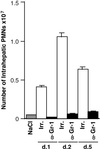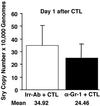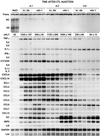Depletion of neutrophils blocks the recruitment of antigen-nonspecific cells into the liver without affecting the antiviral activity of hepatitis B virus-specific cytotoxic T lymphocytes
- PMID: 12368481
- PMCID: PMC129753
- DOI: 10.1073/pnas.172521999
Depletion of neutrophils blocks the recruitment of antigen-nonspecific cells into the liver without affecting the antiviral activity of hepatitis B virus-specific cytotoxic T lymphocytes
Abstract
Using transgenic mice that replicate hepatitis B virus (HBV) in their livers, we previously showed that passively transferred HBV-specific cytotoxic T cells (CTLs) recruit antigen-nonspecific lymphomononuclear and polymorphonuclear inflammatory cells that contribute to the pathogenesis of liver disease. This process is chemokine-dependent, because we recently showed that blocking the chemokines CXCL9 and CXCL10 reduces the recruitment of antigen-nonspecific lymphomononuclear cells and the severity of liver disease after CTL injection. In the current study we show that the severity of the CTL-initiated liver disease is also ameliorated by the depletion of neutrophils. Interestingly, depletion of neutrophils does not affect the intrahepatic migration or antiviral activity of CTLs, but it profoundly inhibits the recruitment of all antigen-nonspecific cells into the liver. This effect occurs in face of high intrahepatic levels of chemokine gene expression, suggesting that neutrophil-dependent functions other than chemokine induction are necessary for the recruitment process to occur. The notion that depletion of neutrophils is associated with maintenance of antiviral effects but diminished tissue damage may be significant for the development of immunotherapeutic approaches for the treatment of chronic HBV infection.
Figures





Similar articles
-
MMPs are required for recruitment of antigen-nonspecific mononuclear cells into the liver by CTLs.J Clin Invest. 2004 Apr;113(8):1158-67. doi: 10.1172/JCI21087. J Clin Invest. 2004. PMID: 15085195 Free PMC article.
-
Vaccination with ubiquitin-hepatitis B core antigen-cytoplasmic transduction peptide enhances the hepatitis B virus-specific cytotoxic T-lymphocyte immune response and inhibits hepatitis B virus replication in transgenic mice.Mol Med Rep. 2015 Sep;12(3):3591-3598. doi: 10.3892/mmr.2015.3834. Epub 2015 May 25. Mol Med Rep. 2015. PMID: 26004262
-
Blocking chemokine responsive to gamma-2/interferon (IFN)-gamma inducible protein and monokine induced by IFN-gamma activity in vivo reduces the pathogenetic but not the antiviral potential of hepatitis B virus-specific cytotoxic T lymphocytes.J Exp Med. 2001 Dec 17;194(12):1755-66. doi: 10.1084/jem.194.12.1755. J Exp Med. 2001. PMID: 11748277 Free PMC article.
-
Hepatitis B virus immunopathogenesis.Annu Rev Immunol. 1995;13:29-60. doi: 10.1146/annurev.iy.13.040195.000333. Annu Rev Immunol. 1995. PMID: 7612225 Review.
-
HBV pathogenesis in animal models: recent advances on the role of platelets.J Hepatol. 2007 Apr;46(4):719-26. doi: 10.1016/j.jhep.2007.01.007. Epub 2007 Jan 29. J Hepatol. 2007. PMID: 17316876 Free PMC article. Review.
Cited by
-
CXCL10 Chemokine: A Critical Player in RNA and DNA Viral Infections.Viruses. 2022 Nov 3;14(11):2445. doi: 10.3390/v14112445. Viruses. 2022. PMID: 36366543 Free PMC article. Review.
-
Polyfunctional type-1, -2, and -17 CD8⁺ T cell responses to apoptotic self-antigens correlate with the chronic evolution of hepatitis C virus infection.PLoS Pathog. 2012;8(6):e1002759. doi: 10.1371/journal.ppat.1002759. Epub 2012 Jun 21. PLoS Pathog. 2012. PMID: 22737070 Free PMC article.
-
The IL-6-gp130-STAT3 pathway in hepatocytes triggers liver protection in T cell-mediated liver injury.J Clin Invest. 2005 Apr;115(4):860-9. doi: 10.1172/JCI23640. Epub 2005 Mar 3. J Clin Invest. 2005. PMID: 15761498 Free PMC article.
-
Intrahepatic expression of genes affiliated with innate and adaptive immune responses immediately after invasion and during acute infection with woodchuck hepadnavirus.J Virol. 2008 Sep;82(17):8579-91. doi: 10.1128/JVI.01022-08. Epub 2008 Jul 2. J Virol. 2008. PMID: 18596101 Free PMC article.
-
Neither neutrophils nor reactive oxygen species contribute to tissue damage during Pneumocystis pneumonia in mice.Infect Immun. 2004 Oct;72(10):5722-32. doi: 10.1128/IAI.72.10.5722-5732.2004. Infect Immun. 2004. PMID: 15385471 Free PMC article.
References
Publication types
MeSH terms
Substances
Grants and funding
LinkOut - more resources
Full Text Sources
Research Materials

